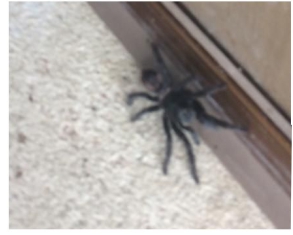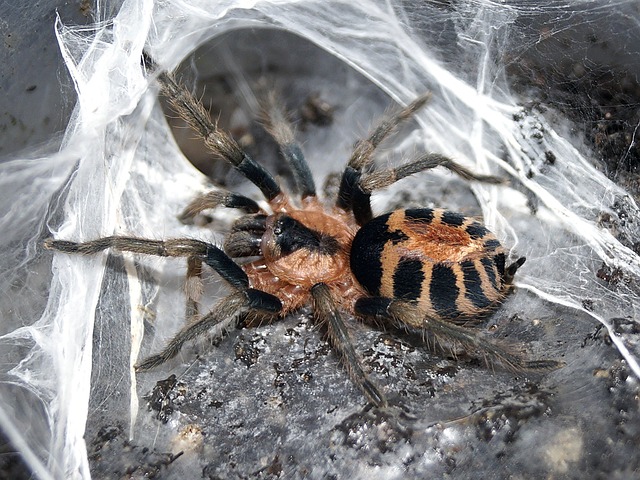Creepy bugs, snakes and a Big Hairy Tarantula – who needs them?!
When I told my friends we were visiting Costa Rica for the first time, we got lots of warnings about the deadly snakes and “Why would we go there?”
Well, two winters in, we did not see so much as a scary bug let alone any snakes.
When we decided to go to Mexico, it was “Aren’t you worried about the crime? What about the snakes, spiders, and tarantulas?”
Well, I am happy to say we have not had any dealings with crime… or snakes…however, we had a creepy-crawly visitor.
Visit from a Tarantula
We had new neighbours move in next door to us and I decided to go and say hello. My husband had gone out to ride his bike and do some errands. Our neighbours had invited him to join us when he came home and I sent him a message telling him where I was.
When he arrived, he hollered through the door, I just need to take care of this tarantula and then have a shower. WHAT?!
The size of tarantulas can vary, ranging anywhere from 4.5 inches to 11 inches, from the front right leg to the rear left leg, and can weigh 1 to 3 ounces. In light of that, this might have been a very young one but I’m not so sure my husband thought so when he took the photo.

Of course, we all had to have a look. It was between our two doors, just sitting there. Ugh! All I could think about was, boy, am I glad I wasn’t the one who found it.
Rescue of a Tarantula
We scurried back to the ‘safety’ of our neighbour’s home and let my husband take care of it. He got our long-handled dustpan and scooped “ Terrance the Tarantula” (yes, he named the darn thing!) into it. He let it go by the side of the street and we watched it cross to the other side. I have to admit it was quite impressive looking as he meandered across the road. (I think we were in too much awe to get another photo!)
Some Hairy Facts
So, is this hairy creature native to Mexico and is it dangerous?
I could never understand the fascination with these 8 legged critters. I know people get them from pet shops. So here is what I learned.
-
Are they native to Mexico?
It turns out that Mexico holds the second-place spot in the world for the number of species and it could very well be number one as only a few people have taken a big interest in them (well, that doesn’t surprise me!).
At last count, there were 66 species in Mexico, with the most common being the Brachypelma genus and the Aphonopelma.
-
How did the Tarantula get its name?
The name tarantula is associated with a myth in the small town of Taranto on the southern coast of Italy. Though unrelated to what we call the tarantulas now, it was named after the town called Tarantola. Legend has it that this spider caused a disease called ‘tarantismo” and melancholy and death were a result of its bite. To avoid this death, it was believed one had to dance a crazy, uncontrolled dance set to music, called the ‘tarantella.”
The question remains though if these spiders were unrelated to the tarantulas of today, how did the name come to be in other areas like Mexico? A lot of the settlers in this area came from southern Spain and Italy and most likely came across big hairy spiders and associated them with their large spiders, the Tarantola, back home.
-
Are tarantulas poisonous or dangerous?
Despite their big size and hairy bodies, they are not poisonous but can inflict a nasty bite. All tarantulas are venomous, not to be confused with poisonous. Bites can cause serious discomfort that might persist for some time. Some bites are severe enough to cause spasms that can recur over several days.
The bite of the African tarantulas can cause strong hallucinations. Should you be the unfortunate recipient of a bite from any tarantula, it is wise to seek medical attention. Allergic reactions can occur in some cases because proteins are present in the toxins. Just for the record, they don’t like to be handled!
-
What can threaten a tarantula?
Are tarantulas immune to other predators? Not! A pregnant parasitic Pepsis wasp will paralyze unsuspecting tarantulas with its sting and lay eggs on its body. When the eggs hatch, the tarantulas are eaten alive by the wasp larvae.
In the wild, tarantulas can live up to 30 years. The male has a much shorter life span than the female.
-
What does a tarantula eat?
Tarantulas are burrowers and typically live in the ground. They are carnivores and nocturnal. Their diet consists mainly of insects (such as crickets, grasshoppers, beetles, cicadas, caterpillars, and other spiders). The bigger game includes mice, frogs, toads, snakes, and lizards; some species can eat small birds.
The tarantulas grab with their legs and then inject venom, paralyzing their unfortunate prey before eating. They secrete digestive enzymes that liquefy the bodies of their victims making it easier to suck them up through their small mouth openings. A good meal can last tarantulas for a month!
-
How do they mate and reproduce?
Contrary to what you might think, the main use of the web isn’t to catch unsuspecting prey but to signal to the female he is ready to mate. He leaves his sperm on the web which his mate will spin into a cocoon with her eggs. A male who has hung around too long may find himself her next meal!

According to National Geographic, it is not uncommon for a single egg sac to contain 500 to 1,000 babies. That’s a very large family.
Other Interesting Facts
. Scientific Name of Tarantula
The scientific name is Theraphosidae.
. The Tarantulas is a Delicacy
Certain cultures in Venezuela and Cambodia consider tarantulas a delicacy. They remove the hairs (which can cause an itch or skin irritation in humans) by roasting them over an open fire, and then they eat them. I think I have to pass on this!
. Moulting
Tarantulas shed their external skeletons. During this process, they also replace internal organs such as the stomach lining, or female genitalia. They can even regrow lost appendages. Generally, a one to 3 year old will moult two to three times, young adults once a year, and a mature adult about every two years.
And for those of you who are still with me, here is an incredible video showing a tarantula’s egg sac as it is being opened. My thoughts on watching this was “That’s a very large bunch of baby tarantulas!”
FINAL THOUGHTS
So, you are probably wondering “Do I like them any BETTER now?” Sorry, but that is still a resounding no! Tarantulas are right up there with snakes.
Do I respect them? Definitely! I know they have a purpose and are important to the ecosystem as they eliminate insect plagues and they are more likely scared of me than I am of them!
How about you? Do you like or own a tarantula?


I think you would’ve heard me scream all the way to Nova Scotia if I saw that thing!! Great, now I’ll be on the look out when I’m in Akumal….*shivering*
Hi Michele. Sorry to put thoughts in your head! You would have heard me screaming if I was the one that came upon it! I honestly don’t know which would scare me most, coming upon a tarantula or a snake. In Costa Rica, anytime I had to walk through a field or grass, I was walking with my head down, lol!
Ok, so if there is one thing I am scared of it is spiders. I was reading this with terror and great curiosity. I do want to over come my fear of spiders it is however really hard because they can hurt you bad. I have always heard that tarantulas couldn’t hurt you, but you are telling me that they can. Gaah! And they can live for how long?! 30 years… wow. I live in Australia and spiders are fairly common, I have however not really seen that many of them, but when you do see them they are big and they fall on you. The only reason I allow spiders in my home is because like you say they do eat bugs etc. As long as they respect my space I will respect theirs.
Hi Alexandra. I too am not fond of spiders and try to get away from them as fast as possible. Yes the tarantulas do have a long life span. Some people just have a nasty reaction if they get bit by one but they are not poisonous and they are good for eating other bugs, etc.
Hmmm I can’t go near such a dangerous creature like tarantula. I hate it. By the way I love the videos and the post for the information it passes. But for Tarantula no, no, no. I don’t think they are of any value to ecosystem other organisms can do their job if they are extinct from the face of earth. Lol
I understand how you feel. I am the same way. Not sure I could ever get close to one! They are good though!
Wow…I saw the article and shuddered. LOL However, once I started reading I was so interested.
I did not know the difference between venomous and poisonous. That took a little (very little) of my fear away. I thought if one bit me I could die. Now I just know that I’ll be uncomfortable. Hopefully I never will find out. 🙂
I am curious…you said that Mexico was the number two spot in the world for the number of species. What is the number one?
Thank you for the interesting article, I’m glad I didn’t click away.
Hi Nancy.
Glad you found the article interesting. I too did not know the difference between poisonous and venomous. I am sure if one bit me, I would probably pass out more from fear than anything else. Kudos to people who have no fear. The majority of tarantulas are found in South America.
First of all– can I just say that I love your husband for naming the tarantula and for not killing it (he is my favorite now!). Tarantulas are actually so incredibly cool. My Uncle had one growing up and it was just so docile, we used to nap with it! My Aunt would pay us a dime for every cricket we caught for her! As a kid, we made a lot of dimes!
I honestly had no idea there were so many different species of tarantula! 66? That’s incredible!
Also, that video was incredible– sad, how the mama did not want her to take the eggs, but the sac looked a very cozy place for the little baby spiders!
Such a cool article!
Thanks for sharing
–Ciara
Hi Ciara. Thank you! I will be sure and tell my husband. It will make his day! I can’t imagine having a pet tarantula but kudos for you not being afraid and actually interacting with it.
I agree about the video. Amazing how many eggs there are!